English

行业
加入成千上万的行业领导者的行列,与 Chiggo 一起推动产品创新。

解决方案
从原材料到生产和产品增强的一站式解决方案。
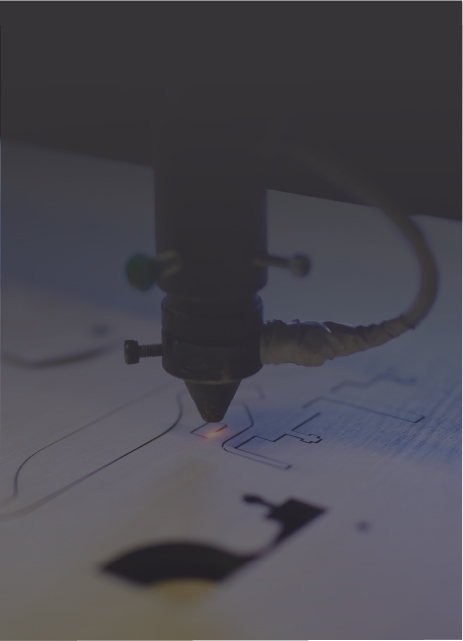
资源
您需要了解的有关数字化制造的一切。
就像铝或 CNC加工材料现代制造业中。这主要是由于铜的出色电气和热导率,高腐蚀性,良好的强度和抗疲劳性以及独特的颜色。此外,它可以很容易地工作,泡沫,焊接和焊接。
我们需要了解铜的特征及其加工细节,以有效地执行CNC加工。请继续阅读 - 本文提供了您想知道的内容。
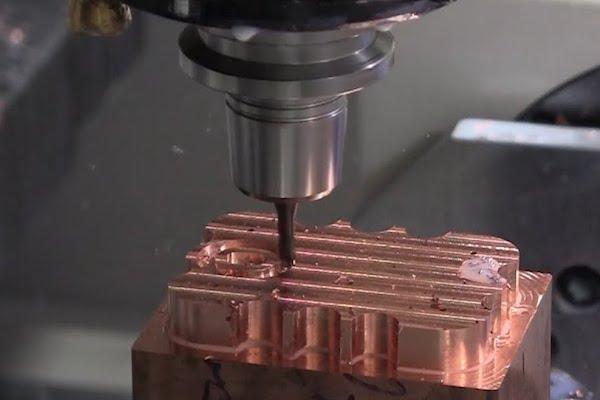
铜CNC加工是精度制造过程使用计算机数值控制(CNC)工具(CNC)工具和机器将铜材料形成所需的塑形。该过程产生具有复杂几何形状和精确尺寸的高质量,可靠的铜件,这在电子,航空航天,汽车和医疗制造等行业中至关重要。
铜在周期表上标记为具有原子数29的Cu。它具有独特的红橙色外观,在热导电性和导电性中仅次于银(Ag)。当我们谈论“铜”时,我们通常是指铜和铜合金。将它们分类的最常见方法是六个家庭:铜,稀释剂(或高铜)合金,黄铜,青铜器,铜尼克尔和镍银。
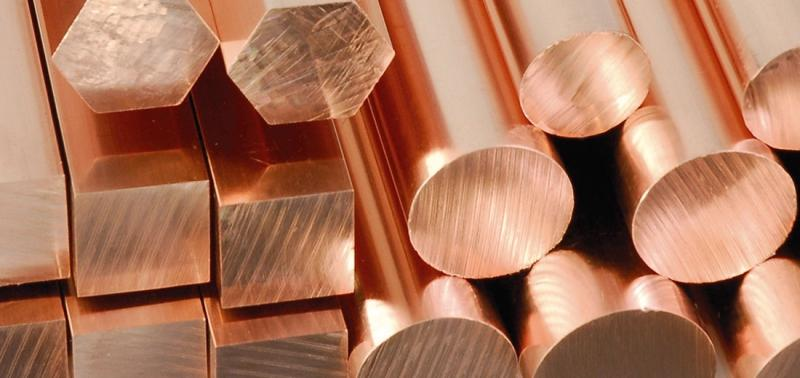
接下来,我们将介绍几种用于加工的铜和稀铜合金的类型。
C10100是最高的铜级铜,铜含量超过99.99%,氧气水平低至0.0005%(银将其视为杂质)。该等级具有出色的电导率(至少101%IACS -国际退火铜标准)和导热率。它的氧气含量非常低,可以最大程度地减少氢含糖的风险,从而无需开裂即可进行深度绘图或高还原图,并允许任何常规过程(例如弧形焊接,抗性焊接,悬挂,悬挂和焊接)将其连接起来,甚至是减少或真空条件。 C10100主要用于真空腔室组件,半导体连接,导线线,玻璃至金属密封和波导。
C10200也是无氧的铜,但纯净的纯度略低于C10100,最低铜含量为99.95%(包括银),氧气含量限制在最高约0.001%。它提供了几乎相同的功能优势,与C10100(无氢损伤等),通常在许多应用中可以互换。本质上,C10200可以被视为C10100的低级版本,以稍低的成本在一般应用中满足对无氧铜的需求。
ETP铜是最常见的铜。它必须至少为99.9%,并且通常具有0.02%至0.04%的氧气。 与铜一样,在确定纯度时,银(Ag)含量被计为铜(CU)。在电导率和导热率方面,C11000的实际性能基本上等于C10100和C10200。今天出售的大多数C11000均达到或超过101%的IACS,用于电导率,并在390 W/m·K附近提供热导率。此外,C11000更经济,被认为是一般电气应用的行业标准。
尽管C11000在正常条件下是非常延展的,但如果在富含氢气的环境中加热,它可能会遭受覆盖。这是因为C11000中的氧气以Cu₂o沉淀而存在,通常位于晶界。在升高的温度下,氢可以扩散到材料中,并与Cu₂o反应形成水蒸气(H₂O)。该反应会产生内部空隙或裂缝,这种现象称为氢含水或“氢疾病”。结果,C11000不适合气体焊接和高温悬挂。如果必须需要焊接,通常是通过在惰性气罩中或电阻焊接中通过电弧焊接(TIG,MIG)完成的,以防止氢拾取。
C12200在机械上也称为磷氧化铜或高磷磷铜,与C11000相似,但包括少量的磷(0.015-0.04%)。此添加有助于从金属中去除氧气,从而提高其焊接性和钎焊能力,同时防止氢化。 C12200也很容易被热形成,并且是变压器绕组,母线和其他需要可靠制造的电气组件的绝佳选择。
C14500是一种稀铜合金,含0.4-0.7%的胎尿和0.004–0.12%的磷。柜形成铜基质内的细分散沉淀物,在加工过程中充当碎屑破裂。与标准的铜可加工性额定值约为20%,这将其可加以可加解的评级提高到80-90%(自由切割的黄铜设定为100%)。它的电导率略有降低被迅速和精确加工的能力所抵消。
由于其出色的可加工性和高表面质量,它通常用于需要高精度切割和光滑表面饰面(例如精确开关,连接器和电子组件)的电气组件和连接器中。但是,柜员的存在对焊接关节稳定性产生负面影响;因此,诸如氧乙二烯焊接,斑点焊接和涂层金属弧焊接等过程通常不适合C14500。
C14700是一种自由装饰的铜合金,类似于C14500,旨在显着增强纯铜的可加工性。它含有0.2–0.5%的硫,形成硫化物沉淀,在C14500中,形态学和分布与牙酸酯沉淀的分布不同。
尽管某些制造商更喜欢C14500对于需要最佳的芯片控制和表面饰面的关键应用,但反馈表明,在某些焊接条件下,C14700中的硫化物沉淀影响焊接关节稳定性小于C14500中的牙萝卜质沉淀。但是,两者都不适合常规焊接。建议使用低温或惰性气体屏蔽电弧焊接(TIG或MIG)。此外,对于成本敏感或要求少的加工应用程序,C14700提供了可观的好处,并且可能更经济。
铜CNC加工过程使用复杂的设备,例如磨坊,研磨机和车床来在铜部件上创建精确而复杂的功能。以下是最常见的技术:
cnc铣削自动化切割速度,进料速度和工具移动,使铜工件的精确形成。它使用多点旋转切割工具,逐渐去除材料,以创建各种设计功能,包括凹槽,轮廓,凹口,平面表面,孔和口袋。由于铜的柔软度,通常使用2卷碳化物端磨机来防止芯片堆积并保持准确性。
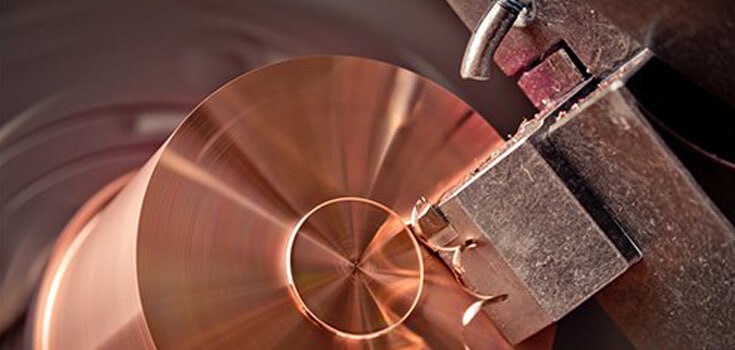
在CNC转动中,旋转的铜工件是由固定的切割工具塑造的。该过程有效地产生了具有紧密公差的圆柱,螺纹和高精度部分。陶瓷或CBN插入物有时用于增加工具寿命和耐磨性。由于其速度和适应性,CNC转弯非常适合大批量生产。该方法相对具有成本效益,适用于加工许多电子和机械组件,例如电线连接器,阀门,总线杆,辐射器。
CNC钻孔在铜零件中创建精确和干净的孔。尽管CNC铣削也可以产生孔,但CNC钻孔专门用于深孔钻孔或高精度孔的形成。为了防止铜粘在钻头上并引起堵塞,使用具有优化切割角的锋利钻头来改善芯片疏散。此外,通常选择涂有锡的钻头以减少摩擦并改善工具寿命。
CNC研磨可完善铜加工的表面表面和尺寸精度。它采用磨料轮来实现紧密的公差和光滑的表面,使其非常适合高端电子或医疗设备。由于铜的涂抹趋势,使用细磨料和受控压力来防止材料变形。
EDM是一种非接触机加工方法,可通过受控的电气放电去除材料。对于很难使用常规工具很难升级的复杂铜设计,这是一个绝佳的选择。该技术对于在航空航天和电子产品中加工薄壁的部分,详细的腔和高精度组件特别有用。 电线EDM 和接收器EDM是两种主要类型。前者用于通过用薄导线作为电极作为二维轮廓(或扁平形状)进行精确切割,而后者则用于机加工三维腔和深孔,在该孔中,电极的形状与所需的几何形状相匹配。尽管EDM比传统方法慢,但它可以创建精确的,复杂的设计,并且机械应力最小。
CNC加工后,铜零件通常会表面处理通过删除加工痕迹,减少氧化和增强的耐腐蚀性,以提高功能性和美观性。
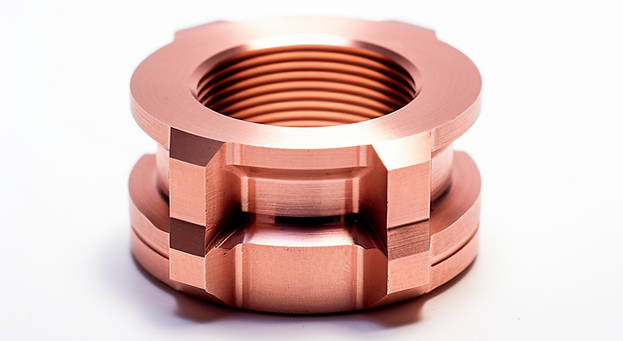
尽管铜被广泛用于其出色的可加工性和热特性,但它在CNC加工中提出了一些独特的挑战。以下是铜CNC加工过程中出现的主要困难。
纯铜很容易地粘附在工具表面上切割工具和形式的构建边缘(BUE),并加速工具降解。这导致加工效率低下和工件表面上的毛刺形成。与铜合金提供更好的芯片形成和可加工性不同,加工纯铜需要专门的工具和过程调整,以确保尺寸的精度和光滑的表面饰面。
铜的高延展性意味着它在加工应力下很容易变形。当它发生塑性变形(尤其是在冷工作期间)时,其晶体结构会累积位错,增加其强度和硬度,这种现象称为工作硬化。硬化的表面需要更高的切割力,并且对工具更加磨损,强调机器并影响尺寸的精度。为了减轻这种情况,使用了优化的切割参数,有效的冷却和润滑以及锋利的高质量工具。
铜具有快速进行和散热的能力,但是快速,局部的温度变化会导致热膨胀或收缩不均匀,从而导致工件失真。此外,过量的热量会降解切割工具。为了防止这些问题,重要的是要管理发热并确保加工过程中有效散热。
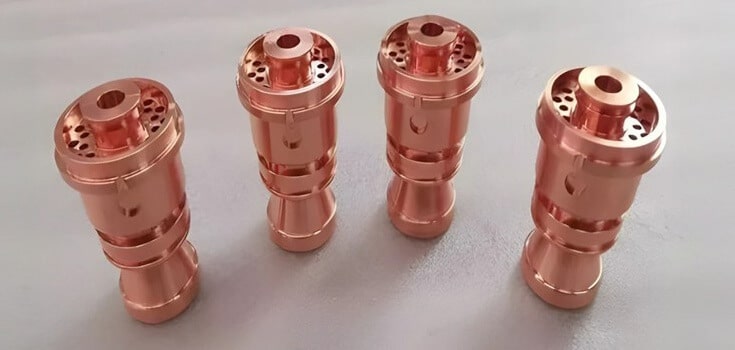
为了应对上述挑战,以下是确保铜的有效且具有成本效益的加工的主要考虑因素。
在加工之前,至关重要的是为您的应用选择最合适的铜材料等级。纯铜很昂贵,机器充满挑战。如果您需要纯铜的特性,但需要一种易于加工的材料,则可以进行自由体验的铜合金(例如柜子铜和含硫的铜),最好用于有效加工,并且更具成本效益。但是,如果还需要更高的机械强度和耐磨性,则
另一个重要的考虑因素是在此过程的早期审查铜零件的设计要求和规格。通过将设计与制造能力保持一致,您可以减少错误,重做,并确保最终部分符合预期的功能。以下是一些设计建议:
饲料率描述了CNC切割工具针对工件的速度。它直接影响工具寿命,表面饰面和加工效率。高饲料速率会导致温度升高太快,从而导致诸如聊天,工具挠度和加工铜的精度降低的问题。为了防止这些问题,建议将低到适中的饲料率应用。
选择右切割工具对于铜CNC加工来说至关重要。碳化物工具是高速加工的首选,因为它们在升高温度下保持硬度并且具有出色的耐磨性。钻石涂层工具最适合纯铜和精密应用,因为它们可以防止芯片堆积和材料粘附。钴高速钢(HSS)工具可用于低速操作,但往往更快。此外,抛光的工具长笛改善芯片疏散并减少材料涂抹。在加工铜之前,请确保将切割工具锐化到锋利的尖端,以获得最佳性能。
铜CNC加工需要精确,专业知识和仔细的材料选择,以进行高质量,具有成本效益的生产。本文提供了指导您的物质选择并帮助您避免常见加工问题的关键见解。但是,成功制造还取决于拥有高级CNC技术和行业专业知识的值得信赖的合作伙伴。对于可靠的铜及其合金的CNC加工, chiggo 在这里提供帮助。 立即与我们联系,让我们开始!

精密加工是一个关键的制造过程,可通过使用最先进的CNC机器产生具有极高尺寸公差和优越表面饰面的组件。这些零件不仅是为了形状而设计的,而且还用于可靠的功能,精确的拟合和可重复性。
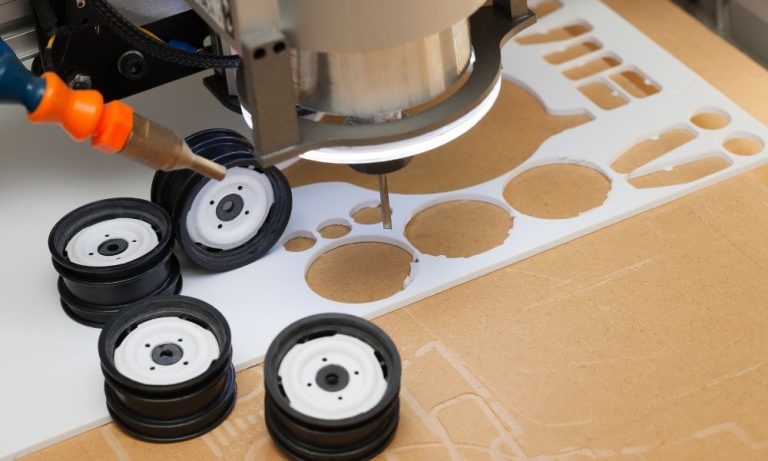
在工业应用中,塑料与金属相比具有多种优势,包括轻质、耐腐蚀、设计灵活性、优异的电绝缘性以及较低的加工和维护成本。随着改性和高性能工程塑料的不断发展,许多传统的以金属为主的应用现已部分或完全被塑料取代。其中,ABS 因其均衡的机械强度、韧性、加工性能、表面光洁度潜力和成本效益而脱颖而出。它在塑料家族中占有重要地位,充当商品塑料和工程塑料之间的桥梁。

终极拉伸强度(UTS)是材料破裂前可以承受的最大应力的度量。通常通过进行拉伸测试并记录工程应力与应变曲线的情况。作为一项密集的特性,UTS对于比较张力下的材料的性能至关重要。它可以帮助工程师为必须抵抗拉伸负荷而不会失败的结构和组件选择合适的材料。

عربي
عربي
中国大陆
简体中文
United Kingdom
English
France
Français
Deutschland
Deutsch
नहीं
नहीं
日本
日本語
Português
Português
España
Español